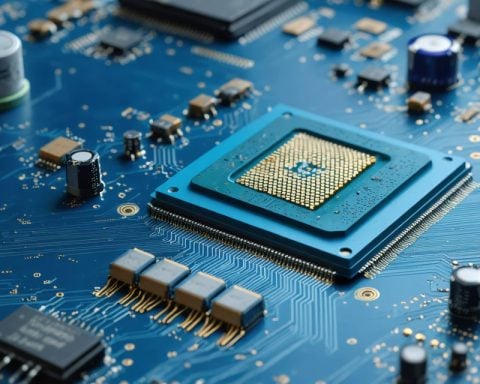- Edward Snowden criticizes NVIDIA’s RTX 5080 for its inadequate 16GB VRAM, citing it as harmful to performance.
- The gap between the RTX 5080 and RTX 5090 highlights industry concerns over insufficient VRAM for high-demand gaming.
- Gamers expect a minimum of 24GB VRAM for premium graphics cards, particularly those priced over $1,000.
- NVIDIA’s line-up, including the RTX 5070 with 12GB and 5060 with 8GB, raises doubts about their commitment to cutting-edge performance.
- With AMD’s RDNA 4 series on the horizon, there are hopes for competitive offerings featuring better VRAM options.
- Consumers are urged to advocate for higher specifications to ensure an optimal gaming experience.
In a surprising turn of events, famed whistleblower Edward Snowden has boldly labeled NVIDIA’s new GeForce RTX 5080 as “a monopolistic crime against the consumer.” His primary grievance? The card’s woefully insufficient 16GB of VRAM, which he believes cripples its performance, particularly as gaming demands rise.
Snowden’s discontent mirrors wider industry frustrations. Tech enthusiasts and reviewers have quickly highlighted the glaring disparity between the RTX 5080’s 16GB and the RTX 5090’s robust 32GB. As games increasingly push the boundaries of technology in stunning 4K graphics, manufacturers are falling short. Imagine diving into a game like “Indiana Jones and the Great Circle,” only to face stuttering and lag because your graphics card can’t keep up!
Many argue that a minimum of 24GB should be standard for a graphics card exceeding $1,000. With NVIDIA’s latest releases feeling like a step back rather than a leap forward, fans are raising eyebrows over the RTX 5070’s 12GB and the expected 5060’s paltry 8GB.
As AMD gears up to launch its RDNA 4 series, the anticipation builds. Will they offer gamers better value with a more generous VRAM allocation?
The clear takeaway? As gaming technology advances, consumers deserve more than just flashy marketing. It’s time for manufacturers to step up and rethink their strategies for a truly satisfying gaming experience. Snowdon’s message resonates: consumers must demand better, or risk being left behind in an increasingly dynamic gaming landscape.
Unmasking the GPU Dilemma: Is NVIDIA’s Strategy Compromising Performance?
As the gaming landscape evolves, NVIDIA’s new GeForce RTX 5080 has recently sparked intense debate, largely due to its inadequate 16GB VRAM as highlighted by whistleblower Edward Snowden. This critique not only emphasizes consumer discontent but also reflects broader industry concerns over gaming technology’s cruel balancing act between price and performance.
Trends and Insights
1. Market Analysis: The graphics card industry is rapidly shifting towards higher VRAM demands as games evolve to support higher resolutions and more intricate graphics. The push for 4K gaming is becoming a standard, making NVIDIA’s current offerings seem outdated.
2. Innovations and Upcoming Releases: AMD’s anticipated RDNA 4 series could potentially disrupt the market by providing more competitive VRAM allocations, which may cater better to gamers’ needs.
3. Sustainability: As technology advances, the sustainability aspect comes into play. A GPU that demands frequent upgrades due to insufficient performance may lead to increased electronic waste. Consumers are becoming more environmentally conscious, thus pressuring manufacturers to create longer-lasting, more capable products.
Key Features and Specifications
– GeForce RTX 5080: 16GB VRAM, touted for powerful performance but criticized for being insufficient for next-gen gaming.
– GeForce RTX 5090: 32GB VRAM, which is seen as more future-proof, catering to the increasing demand for higher graphical fidelity.
– RTX 5070: 12GB VRAM, seen as inadequate for modern gaming demands.
– Expected RTX 5060: 8GB VRAM, which prompts concerns over its viability in demanding gaming scenarios.
Limitations
While NVIDIA’s RTX 5080 may excel in certain areas, the primary limitation remains the VRAM size. This insufficiency compromises the performance, especially for gamers who desire seamless experiences in high-demand titles like “Indiana Jones and the Great Circle”.
Pricing Landscape
The RTX 5080 is priced at over $1,000. Given this price point, many consumers expect superior performance, particularly with regards to VRAM capacity. The current trend indicates a demand for at least 24GB in graphics cards above this price threshold to justify the investment.
Most Important Questions Answered
1. Why is VRAM important for gaming?
VRAM is crucial for storing textures and rendering graphics. Higher VRAM allows for better performance in higher resolutions and more complex graphics, minimizing lag and stuttering.
2. How does NVIDIA’s current strategy affect consumers?
NVIDIA’s strategy, with lower VRAM options, may alienate consumers who expect their graphics cards to last and perform well amid increasing gaming demands. Market pressures are thus mounting for higher specifications.
3. What are competitors like AMD doing differently?
AMD appears poised to potentially provide more VRAM for their RDNA 4 series, which could create competitive pressure on NVIDIA to improve their offerings. This could lead to better value and performance options for consumers.
For more insights into NVIDIA’s products, check out NVIDIA’s main page.



















